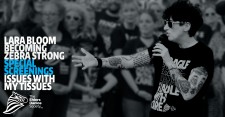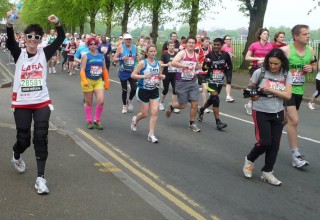
Patient Advocate and International Executive Director Lara Bloom to screen inspiring documentary, "Issues with my Tissues," to empower patients, families, and raise awareness for EDS and associated disorders
BALTIMORE, October 9, 2018 (Newswire.com) - The Ehlers-Danlos Society is proud to announce its first International Ehlers-Danlos syndromes (EDS) and hypermobility spectrum disorders (HSD), awareness tour, “Becoming Zebra Strong,” featuring Lara Bloom, International Executive Director of The Ehlers-Danlos Society. Hosted by local affiliates from Northern California to South East England, event includes public screenings of Bloom’s 2015 documentary,“Issues With My Tissues.”
The acclaimed documentary follows Lara’s seemingly unthinkable journey to raise awareness and funding for EDS research by achieving what her doctors believe to be the impossible—becoming the first known person living with EDS to complete the London Marathon.
Becoming #ZebraStrong in the face of adversity and chronic pain
Affected by numerous multisystemi cchallenges for nearly three decades, Bloom’s diagnosis of hypermobile EDS (hEDS) serves as a catalyst for nothing less than a total metamorphosis.
Driven to reconstruct her life, physically, emotionally, and spiritually, Bloom embarks on a journey of total transformation.
Despite rarely walking more than a few miles at any point in her life, the film documents Bloom’s training, her pain, her endurance—including her heroic drive to complete the final thirteen miles on a fractured foot—and her ultimate triumph, as Bloom pushes herself to successfully finish the entire 2011 marathon, in just eight hours and 18 minutes.
To get across the finish line, Bloom seeks out the advice of renowned medical professionals and numerous families and individuals whose suffering has been compounded by years of misdiagnosis, uneven treatment, and the heart-wrenching challenges of life with EDS.
Following each screening, Bloom will answer questions and discuss how people can become “ZebraStrong” in the face of EDS, HSD, and the numerous related symptoms and associated conditions, which confront those living with these disorders.
All events are free and open to the public. For more information and to RSVP, please click here.
Current schedule includes:
SAN FRANCISCO METRO AREA
Tuesday, October 9th
7:00 PM to 9:00 PM
5353 Betsy Ross Dr.
Santa Clara, CA
Wednesday, October 10th
7:00 PM to 9:00 PM
Ed Roberts Campus
Osher BC
3075 Adeline Street
Berkeley, CA
LOS ANGELES METRO AREA
Thursday, October 18th
4:30 PM to 6:00 PM
Laemmle Claremont
450 W 2nd Street
Claremont, CA
MARYLAND
Tuesday, October 23rd
7:00 PM to 8:45 PM
Miller Branch Library
Ellicott Room
9421 Frederick Rd
Ellicott City, MD
WASHINGTON, DC
Thursday, October 25th
6:30 PM to 8:30 PM
Tenley-Friendship Library
Second Floor Large Conference Room
4450 Wisconsin Avenue, NW
Washington, DC
NEW YORK CITY
Tuesday, October 30th
6:30 PM to 8:30 PM
92nd Street Y
2nd Floor, Room S252
1395 Lexington Ave
Manhattan, NY
RHODE ISLAND/SOUTHERN MASSACHUSETTS
Sunday, November 4th
4:00 PM to 6:00 PM
Bell Street Chapel Unitarian Church
3 Bell Street
Providence, RI
UCKFIELD, EAST SUSSEX, UK
Wednesday, November 21
7:00 PM
Temple Grove Care Home
Herons Ghyll
Uckfield
East Sussex TN22 4BY UK
ABOUT THE EHLERS-DANLOS SOCIETY
The Ehlers-Danlos Society is a global community of patients, caregivers, healthcare professionals and supporters dedicated to saving and improving the lives of those affected by the Ehlers-Danlos syndromes, hypermobility spectrum disorders, and related conditions.
A 501(c)(3) nonprofit organization with offices in the U.S. and the U.K., we support collaborative research, education, advocacy, community-building and care for people with EDS and HSD.
The Ehlers-Danlos Society seeks to grow worldwide awareness — and a better quality of life for all who suffer from these conditions. Research is at the center of what we do so that one day we will have a cure.
ABOUT THE EHLERS-DANLOS SYNDROMES AND HYPERMOBILITY SPECTRUM DISORDERS
The Ehlers-Danlos syndromes (EDS) are a group of 14 heritable connective tissue gene disorders that produce a spectrum of complex problems across multiple systems of the body. The physical characteristics that are common to all types of EDS include hypermobile joints, skin hyperextensibility, and tissue fragility. EDS is known to affect more than one in 5,000 men and women of every race and ethnicity.
Each person’s case of Ehlers-Danlos syndrome is unique. Severity may range dramatically, even within families. Prognosis depends on the type of Ehlers-Danlos syndrome and the individual.
Hypermobile Ehlers-Danlos Syndrome (hEDS)
Hypermobile EDS (hEDS) typically begins with extreme joint hypermobility, joints which can stretch beyond normal limits; a propensity for sprains, strains, subluxations and dislocations; pain, often in lower limbs, and with fine motor or repetitive tasks; and easy fatigability.
Although each person with hEDS faces their own set of problems out of the wide range of possible effects, hEDS generally evolves. The initial “hypermobility” phase may involve the ability to hyperextend various body parts to extremes normally attributed to contortionists, gymnasts or elite dancers. Over time, the extreme hypermobility and connective tissue instability of hypermobile EDS may lead to permanent injuries. The “pain” phase involves widespread and worsening pain and headache; pelvic pain in women; and worsened fatigue. The “stiffness” phase seen in some adults and in the elderly results in general reduction in joint hypermobility; significant losses in functionality because of disabling pain and fatigue; and increased limitations, due to reduced muscle mass and weakness, prior injuries and arthritis.
While certain features of hypermobile EDS are not yet in the diagnostic criteria — as more research is needed to prove causation and the relationships between the hEDS and potential comorbidities — clinical descriptions of hEDS have expanded beyond joint hypermobility to include: chronic pain and fatigue, gastrointestinal disorders, neurological issues, dysautonomia, and anxiety. As of this time, hypermobile EDS has no identified distinctive cause.
Hypermobility Spectrum Disorders (HSD)
The hypermobility spectrum disorders (HSD) describe patients with symptomatic joint hypermobility not corresponding to other known conditions. The spectrum of HSD ranges from secondary musculoskeletal manifestations and a simplified categorization of genetic syndromes featuring joint hypermobility.
Vascular Ehlers-Danlos Syndrome (vEDS)
Life expectancy can be significantly shortened for those with the Vascular Ehlers-Danlos syndrome (vEDS) due to the potential for organ and/or blood vessel rupture. While significantly diminished life expectancy is not usually a factor in the other types, quality of life can be severely affected by chronic pain, disability, and myriad comorbidities. There are no cures for the Ehlers-Danlos syndromes, but there are treatments which address many symptoms and preventative measures that may help slow their progression.
Source: The Ehlers-Danlos Society
Share:



